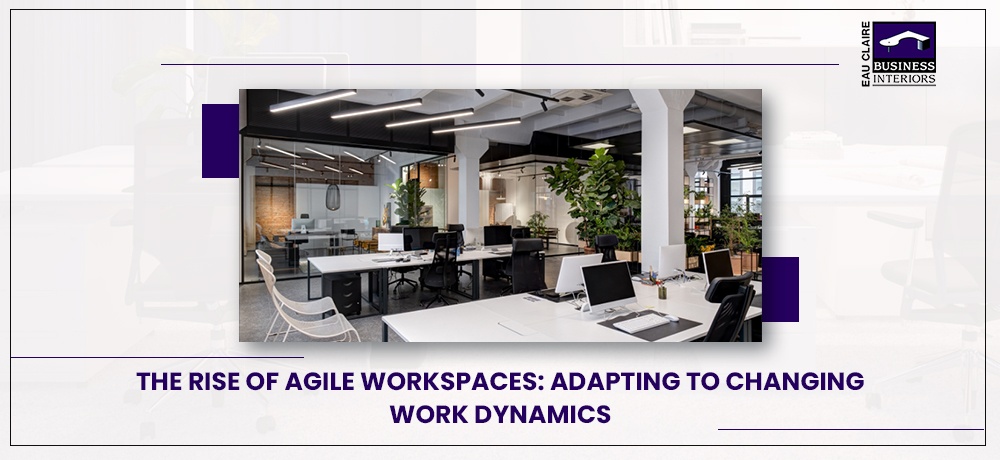The Rise of Agile Workspaces: Adapting to Changing Work Dynamics

The traditional concept of a fixed office space with assigned desks and rigid workstations is rapidly evolving. With the changing dynamics of work, businesses are recognizing the importance of creating agile workspaces that foster flexibility, collaboration, and adaptability. Agile workspaces provide employees with the freedom to choose where and how they work, promoting productivity, creativity, and overall job satisfaction. In this blog post, we will explore the rise of agile workspaces and discuss how businesses can adapt to these changing work dynamics.
1.) Understanding Agile Workspaces:
Agile workspaces are designed to support a variety of work styles and activities. They emphasize flexibility, mobility, and the ability to quickly adapt to changing needs. These spaces are not tied to specific individuals or departments but are rather shared resources that employees can utilize based on their tasks and preferences. Agile workspaces often include open-plan areas, collaborative zones, breakout rooms, and flexible furniture arrangements that allow for easy reconfiguration.
2.) Fostering Collaboration and Communication:
Agile workspaces promote collaboration and communication among employees. By breaking down physical barriers and providing open and accessible spaces, employees can collaborate more easily and share ideas in real time. Incorporating collaborative tools, such as whiteboards, interactive displays, and video conferencing technology, further facilitates effective communication among team members, whether they are physically present or remote. Agile workspaces encourage a culture of teamwork and create opportunities for innovative thinking and problem-solving.
3.) Embracing Activity-Based Working:
Activity-based working is a key component of agile workspaces. It involves creating different areas within the office that are tailored to specific activities or work styles. For example, there may be designated spaces for focused work, team collaboration, brainstorming sessions, or informal discussions. By providing employees with a range of work settings, they can choose the environment that best suits their needs at any given time, leading to increased productivity and satisfaction.
4.) Supporting Remote and Flexible Work:
The rise of agile workspaces aligns with the growing trend of remote and flexible work arrangements. Agile environments accommodate employees who split their time between working from home, co-working spaces, and the office. These spaces provide the necessary infrastructure and technology to support seamless collaboration and communication across different locations. By embracing remote and flexible work, businesses can attract and retain top talent while fostering a healthy work-life balance.
5.) Balancing Collaboration and Privacy:
Agile workspaces strike a balance between collaborative areas and spaces that offer privacy and focused work. It is important to provide options for employees to work individually when they need to concentrate on tasks requiring deep focus. Incorporate quiet zones, private booths, or soundproof rooms where employees can retreat and work without distractions. Balancing collaboration and privacy ensures that employees have the right environment for different types of work, promoting efficiency and well-being.
6.) Incorporating Technology and Digital Tools:
Technology plays a crucial role in enabling agile workspaces. Businesses should invest in robust IT infrastructure, reliable Wi-Fi, and seamless connectivity to support digital collaboration and communication. Implement project management tools, cloud-based storage, and digital collaboration platforms that allow teams to work together effectively, regardless of their physical location. By leveraging technology, businesses can bridge the gap between remote and in-office employees, fostering a cohesive and connected workforce.
7.) Prioritizing Employee Well-being:
Agile workspaces should prioritize employee well-being. Provide comfortable and ergonomic furniture, access to natural light, and breakout areas for relaxation and rejuvenation. Consider incorporating elements of biophilic design, such as plants and natural materials, to enhance the well-being and overall experience of employees. By creating a supportive and health-conscious workspace, businesses can foster employee satisfaction and productivity.
The rise of agile workspaces reflects the changing dynamics of work and the need for flexibility, collaboration, and adaptability. By embracing agile workspaces, businesses can create environments that support collaboration and communication, embrace activity-based working, accommodate remote and flexible work, balance collaboration and privacy, incorporate technology, and prioritize employee well-being. Adapting to these changing work dynamics enables businesses to stay competitive, attract top talent, and create a productive and engaging work environment that promotes success in the ever-evolving workplace.